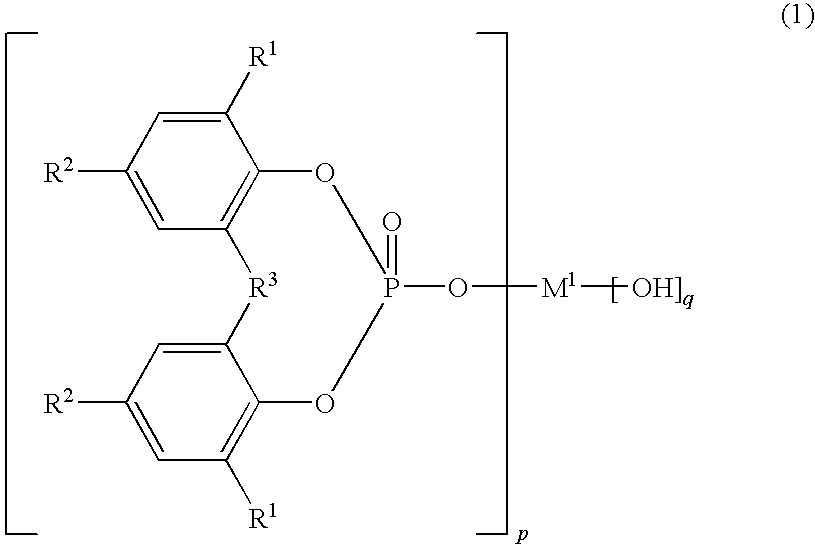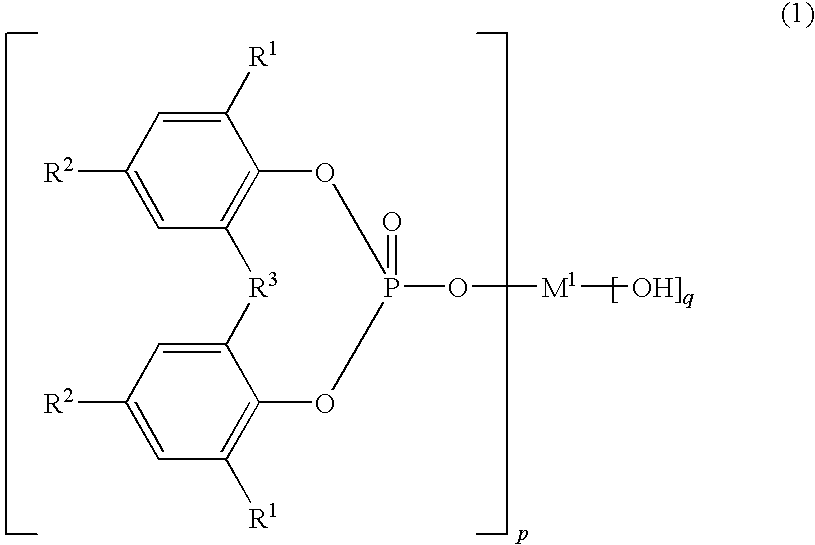Nucleating agent masterbatch for polyolefin resin
a technology of polyolefin resin and masterbatch, which is applied in the direction of organic chemistry, group 5/15 element organic compounds, chemical apparatus and processes, etc., can solve the problems of insufficient strength of molded articles, affecting the shape of molded articles, and affecting the forming cycle, so as to improve the transparency and mechanical physical properties, excellent heat coloring resistance, and excellent compatibility
- Summary
- Abstract
- Description
- Claims
- Application Information
AI Technical Summary
Benefits of technology
Problems solved by technology
Method used
Image
Examples
example 1-1
[0075]To 100 parts by mass of homopolypropylene resin (Melt Index 8-9), 0.1 parts by mass of phenol antioxidant; tetrakis[methylene-3-(3′,5′-di-tert-butyl-4′-hydroxyphenyl)propionate]methane, 0.1 parts by mass of phosphorus antioxidant; tris(2,4-di-tert-butylphenyl) phosphite, 0.05 parts by mass of calcium stearate and the masterbatch (MB-1) which was previously produced according to the formulation indicated in Table 1 above were added in such a manner that the amount of aromatic phosphate ester metal salt compound component (Component (B)) was 0.1 parts by mass with respect to the homopropylene resin. The resultant was mixed for 5 minutes using Henschel mixer at 1,100 rpm and the thus obtained mixture was extruded at 250° C. and 160 rpm to produce a pellet. This pellet was then used for injection molding at 230° C. to obtain a test piece having a thickness of 1 mm, which was evaluated for the haze value (JIS K7105) and bending modulus (ASTM D-790). The results are shown in Table 4...
examples 2-1 to 2-3
and Comparative Examples 2-1 to 2-5
[0077]To 100 parts by mass of homopolypropylene resin (Melt Index 8-9), 0.1 parts by mass of phenol antioxidant; tetrakis[methylene-3-(3′,5′-di-tert-butyl-4′-hydroxyphenyl)propionate]methane, 0.1 parts by mass of phosphorus antioxidant; tris(2,4-di-tert-butylphenyl) phosphite, 0.05 parts by mass of calcium stearate and the masterbatches indicated in Table 5 below were added in such a manner that the amount of aromatic phosphate ester metal salt compound component (Component (B)) was 0.2 parts by mass with respect to the homopropylene resin. The resultants were mixed for 5 minutes using Henschel mixer at 1,100 rpm and the thus obtained mixtures were extruded at 250° C. and 160 rpm to produce pellets. These pellets were then used for injection molding at 230° C. to obtain test pieces having a thickness of 1 mm, which were evaluated for the haze value, bending modulus and Y.I. (Yellow Index: differential colorimeter produced by Suga Test Instruments C...
examples 3-1 to 3-2
and Comparative Example 3-1
[0078]To 100 parts by mass of homopolypropylene resin (Melt Index 7-8), 0.1 parts by mass of phenol antioxidant; tetrakis[methylene-3-(3′,5′-di-tert-butyl-4′-hydroxyphenyl)propionate]methane, 0.1 parts by mass of phosphorus antioxidant; tris(2,4-di-tert-butylphenyl) phosphite, 0.05 parts by mass of calcium stearate and the masterbatches indicated in Table 6 below were added in such a manner that the amount of aromatic phosphate ester metal salt compound component (Component (B)) was 0.2 parts by mass with respect to the homopropylene resin. The resultants were mixed for 5 minutes using Henschel mixer at 1,100 rpm and the thus obtained mixtures were extruded at 250° C. and 160 rpm to produce pellets. These pellets were then used for injection molding at 230° C. to obtain test pieces having a thickness of 1 mm, which were evaluated for the haze value and bending modulus. The results are collectively shown in Table 6 below.
PUM
 Login to View More
Login to View More Abstract
Description
Claims
Application Information
 Login to View More
Login to View More - R&D
- Intellectual Property
- Life Sciences
- Materials
- Tech Scout
- Unparalleled Data Quality
- Higher Quality Content
- 60% Fewer Hallucinations
Browse by: Latest US Patents, China's latest patents, Technical Efficacy Thesaurus, Application Domain, Technology Topic, Popular Technical Reports.
© 2025 PatSnap. All rights reserved.Legal|Privacy policy|Modern Slavery Act Transparency Statement|Sitemap|About US| Contact US: help@patsnap.com



